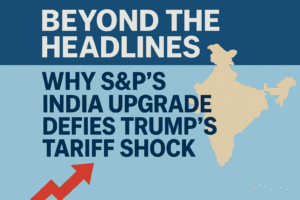Beyond the Headlines: Why S&P’s India Upgrade Defies Trump’s Tariff Shock
Defying immediate pressure, S&P Global’s upgrade of India’s sovereign rating to BBB (stable) just days after steep US tariffs underscores a profound confidence in the economy’s underlying resilience. While acknowledging the real threat of Trump’s punitive 50% tariffs – which could slash exports and risk 1% of GDP – S&P deemed the impact “manageable” and unlikely to derail long-term prospects. Crucially, the agency highlighted India’s massive domestic consumption engine, driving over 60% of growth, as a powerful internal buffer against such external shocks.
This resilience, coupled with the enhanced credibility of India’s monetary policy in anchoring inflation and the government’s commitment to fiscal discipline and smarter spending, underpinned the decision. Backed by robust projected growth of 6.8% annually, the upgrade was instantly validated by markets through falling bond yields and a stronger rupee. Ultimately, S&P’s move signals that India’s structural strengths – its vast internal market, policy maturity, and sustained growth momentum – now demonstrably outweigh significant external political volatility, marking recognition of its hard-won economic resilience.

Beyond the Headlines: Why S&P’s India Upgrade Defies Trump’s Tariff Shock
The timing couldn’t have been more striking. Just days after former US President Donald Trump imposed a punishing additional 25% tariff on Indian goods – raising the total levy to 50% – citing India’s continued purchases of Russian oil, S&P Global Ratings delivered a powerful vote of confidence. In a move resonating through global markets, S&P upgraded India’s sovereign credit rating from BBB- to BBB with a stable outlook, placing it alongside economies like Mexico and Indonesia.
This upgrade isn’t merely a technical adjustment; it’s a profound statement about India’s evolving economic resilience and the perceived limits of external political pressure.
The Tariff Shockwave: A Real Threat
Trump’s tariff action, a stark escalation in trade tensions, wasn’t a minor ripple. Estimates from Bloomberg Economics painted a grim picture: a potential 60% drop in Indian exports to the US, threatening nearly 1% of India’s GDP. This move targeted a critical vulnerability – India’s need for affordable energy imports amidst the Ukraine conflict, highlighting the geopolitical tightrope the nation walks.
S&P’s Calculated Confidence: Looking Beyond the Noise
Despite this immediate threat, S&P’s rationale for the upgrade cut through the short-term turbulence, focusing on deep-seated strengths:
- Unshakeable Domestic Engine: Crucially, S&P emphasized that over 60% of India’s economic growth is driven by domestic consumption. This massive internal market acts as a powerful shock absorber. While acknowledging the tariffs could cause a “one-off hit,” S&P deemed the overall impact “marginal” and insufficient to “derail India’s long-term growth prospects.”
- Monetary Policy Maturity: S&P lauded India’s “enhanced monetary policy environment,” specifically the Reserve Bank of India’s (RBI) success in anchoring inflation expectations. This credibility provides stability crucial for long-term investment.
- Fiscal Discipline (with Nuance): The rating agency acknowledged the government’s “commitment to fiscal consolidation” and “efforts to improve spending quality.” While India’s fiscal deficit remains significant, the direction of travel and focus on infrastructure investment were seen as positive credit factors.
- Robust Growth Trajectory: S&P projects India’s GDP to grow at 6.8% annually over the next three years, exceeding the RBI’s current 6.5% forecast for this fiscal year. This sustained, high growth potential is a fundamental pillar of the upgrade.
Market Validation & Government Relief
The market response was immediate and decisive, confirming S&P’s analysis. Indian 10-year sovereign bond yields fell sharply by 10 basis points to 6.38%, signaling lower perceived borrowing risk and higher bond prices. The rupee strengthened, reflecting increased investor confidence. The Indian government, predictably, welcomed the upgrade as validation of its economic strategy, highlighting the focus on “fiscal consolidation,” “strong infrastructure drive,” and “inclusive growth.”
The Deeper Insight: Resilience Trumps Volatility
S&P’s decision sends several crucial messages:
- Endogenous Strength Matters: A large, growing domestic consumer base provides critical insulation against external trade shocks, a lesson increasingly relevant in a fragmenting global economy.
- Institutional Credibility Counts: The RBI’s effective inflation management is now a recognized pillar of India’s economic stability, directly influencing sovereign risk assessments.
- Long-Term Vision Over Short-Term Noise: Rating agencies, while acknowledging geopolitical risks, are placing greater weight on sustained structural reforms and growth potential than on transient political actions, even significant ones like major tariffs.
- India’s Economic Evolution: The upgrade signifies recognition that India’s economic fundamentals – its market size, policy framework, and growth momentum – have matured to a point where they can withstand significant external pressure.
The Road Ahead
While the BBB rating is a significant milestone, challenges remain. Managing the fiscal deficit, navigating complex geopolitics (especially concerning Russia and energy imports), creating sufficient jobs for a young population, and sustaining high-quality growth require continued focus. The Trump tariffs, while deemed manageable by S&P, still represent a tangible economic headwind for affected exporters.
In essence, S&P‘s upgrade is less about ignoring the storm clouds and more about recognizing the sturdiness of India’s economic ship. It underscores a belief that India’s internal drivers and policy frameworks are now robust enough to sail through significant external turbulence, a testament to its hard-won economic resilience. The world is taking note that India’s growth story, powered from within, is becoming increasingly difficult to derail.
You must be logged in to post a comment.